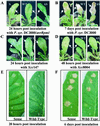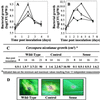A R2R3-MYB gene, AtMYB30, acts as a positive regulator of the hypersensitive cell death program in plants in response to pathogen attack
- PMID: 12119395
- PMCID: PMC126644
- DOI: 10.1073/pnas.152047199
A R2R3-MYB gene, AtMYB30, acts as a positive regulator of the hypersensitive cell death program in plants in response to pathogen attack
Abstract
Hypersensitive response (HR) is a programmed cell death that is commonly associated with disease resistance in plants. Among the different HR-related early induced genes, the AtMYB30 gene is specifically, rapidly, and transiently expressed during incompatible interactions between Arabidopsis and bacterial pathogens. Its expression was also shown to be deregulated in Arabidopsis mutants affected in the control of cell death initiation. Here, we demonstrate that overexpression in Arabidopsis and tobacco of AtMYB30 (i) accelerates and intensifies the appearance of the HR in response to different avirulent bacterial pathogens, (ii) causes HR-like responses to virulent strains, and (iii) increases resistance against different bacterial pathogens, and a virulent biotrophic fungal pathogen, Cercospora nicotianae. In antisense AtMYB30 Arabidopsis lines, HR cell death is strongly decreased or suppressed in response to avirulent bacterial strains, resistance against different bacterial pathogens decreased, and the expression of HR- and defense-related genes was altered. Taken together, these results strongly suggest that AtMYB30 is a positive regulator of hypersensitive cell death.
Figures






References
-
- Richberg M H, Aviv D H, Dangl J L. Curr Opin Plant Biol. 1998;1:480–485. - PubMed
-
- Keen N T, Ersek T, Long M, Bruegger B, Holliday M. Physiol Plant Pathol. 1981;18:325–337.
-
- Levine A, Pennell R I, Alvarez M E, Palmer R, Lamb C. Curr Biol. 1996;6:427–437. - PubMed
-
- He S Y, Huang H C, Collmer A. Cell. 1993;73:1255–1266. - PubMed
Publication types
MeSH terms
Substances
LinkOut - more resources
Full Text Sources
Other Literature Sources
Molecular Biology Databases

